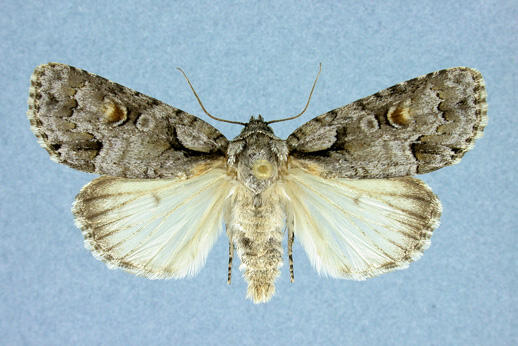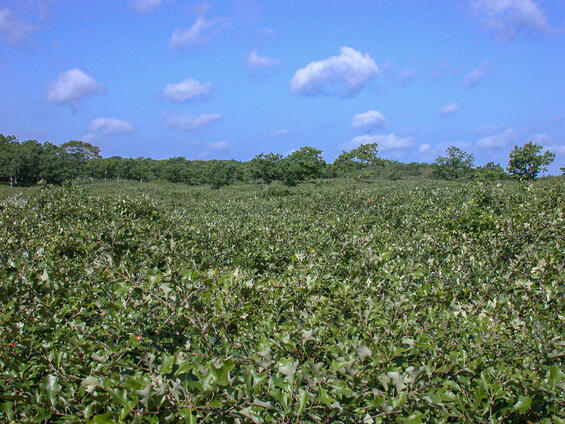- Scientific name: Acronicta albarufa
- Species of Greatest Conservation Need (MA State Wildlife Action Plan)
- Threatened (MA Endangered Species Act)
Description

Barrens dagger moth, Acronicta albarufa
The barrens dagger (Acronicta albarufa) is a noctuid moth with a wingspan of 30-35 mm (1.2-1.4 in) (Forbes 1954). The forewing is gray, mottled with black and white. The postmedial line is black, margined with white proximally, descending in a jagged line from the costa, then curving abruptly inward toward the median area, then again curving abruptly to descend in a straight line from just below the kidney-shaped reniform spot to the inner margin. A black anal dash and a black basal dash are present; the latter curves toward the costa. The reniform spot is rusty brown in color and the orbicular spot round, often white with a gray center. The hind wing of the male is white with a grayish-brown margin and (often obscure) discal spot; the hind wing of the female is grayish-brown, darker at the margin and with an obscure discal spot. The head and thorax are concolorous with the gray of the forewings; the abdomen is lighter, grayish-brown. In Massachusetts, the barrens dagger is most often confused with the ovate dagger (Acronicta ovata) and southern oak dagger (Acronicta increta). Compared to the barrens dagger, the forewing of the former is typically lighter gray, and the forewing of both less evenly gray overall, with lighter gray in the median area and more dark shading in the basal and anal areas. Both the ovate and southern oak dagger have a basal dash that splits distally, forming a ‘Y’ with one branch curving toward the costa and another toward the inner margin. Compared to the rusty brown reniform spot of the barrens dagger, that of the ovate dagger is typically more yellow, while that of the southern oak dagger is pale yellow, or lacking pigment other than gray. Unlike the white hind wing of the male barrens dagger, the hind wing of the male ovate and male southern oak dagger is grayish-brown, only slightly lighter in color than the female of each species, respectively.
Life cycle and behavior

In Massachusetts, the barrens dagger moth flies from mid-June through mid-August. Larvae feed from summer into early fall, and pupae overwinter. In years with an early, warm spring, this species may have a facultative second brood. In Massachusetts the primary host plant is scrub oak (Quercus ilicifolia), though other oak species may occasionally be used.
Distribution and abundance
The barrens dagger moth is found from southeastern Massachusetts south to North Carolina, and west to southern Manitoba and Arkansas (Wagner et al. 2011). Populations occur in restricted, disjunct areas within this range, with major populations in the Ozark Mountains of Missouri and Arkansas and the pine barrens of southern New Jersey and southeastern Massachusetts (Schweitzer et al. 2011).

Distribution in Massachusetts.
1999-2024
Based on records in the Natural Heritage Database.
Habitat
In Massachusetts, the barrens dagger moth inhabits xeric (dry), open pitch pine-scrub oak barrens and scrub oak thickets on sandy soil.
Healthy habitats are vital for supporting native wildlife and plants. Explore habitats and learn about conservation and restoration in Massachusetts.

Sandplain pitch pine-scrub oak barrens habitat with sparse trees and abundant scrub oak, ideal habitat for the barrens dagger moth. Habitat managed by DCR and TNC at Manuel F. Correllus State Forest.
Threats
The barrens dagger moth is threatened by habitat loss and fire suppression in its disturbance-dependent habitats, in particular sandplain pitch pine-scrub oak barrens. Other potential threats include introduced generalist parasitoids, aerial insecticide spraying, non-target herbicide use, and off-road vehicles. The effect of a warming climate may not be detrimental to this species in Massachusetts; its range extends south to North Carolina, suggesting adaptation to warmer temperatures.
Conservation
Land protection and habitat management are the primary conservation needs of this species in Massachusetts. In particular, sandplain pitch pine-scrub oak barrens should be conserved, restored, and managed to maintain habitat for this species and the entire suite of rare and threatened species dependent on such habitat.
Survey and monitoring
The distribution of the barrens dagger moth in coastal sandplain pitch pine-scrub oak barrens is well documented. Known populations of this species should be surveyed to document persistence at least once every 25 years; every 10 years is more desirable when practicable.
Management
Management of sandplain pitch pine-scrub oak barrens benefits a suite of rare and threatened species, and habitat condition should be monitored and management adapted as needed. For the barrens dagger moth, open barrens with a shrub layer including scrub oak are of particular importance.
Research needs
The natural history and conservation needs of the barrens dagger moth are relatively well known. While this species has a single primary brood in Massachusetts, it is capable of a second. The second brood appears to be partial, possibly dependent on annual weather, but this has not been well studied. As with other species with a geographic range mostly south of Massachusetts, the future effects of a warming climate on this species are unpredictable and should be documented. While scrub oak is the main larval host plant, its occurrence in oak woodland on Martha’s Vineyard suggests the possibility that other oak species may be fed upon.
References
Forbes, W.T.M. 1954. Lepidoptera of New York and Neighboring States. Part III. Memoir 329, Cornell University Agricultural Experiment Station, Ithaca, New York. 433 pp.
Schweitzer, D.F., M.C. Minno, and D.L. Wagner. 2011. Rare, Declining, and Poorly Known Butterflies and Moths (Lepidoptera) of Forests and Woodlands in the Eastern United States. Forest Service, U.S. Dept. of Agriculture, Washington, DC. 517 pp.
Wagner, D.L., D.F. Schweitzer, J.B. Sullivan, and R.C. Reardon. 2011. Owlet Caterpillars of Eastern North America. Princeton University Press, Princeton, New Jersey. 576 pp.
Contact
| Date published: | March 6, 2025 |
|---|